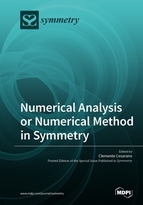Numerical Analysis or Numerical Method in Symmetry
A special issue of Symmetry (ISSN 2073-8994). This special issue belongs to the section "Mathematics".
Deadline for manuscript submissions: closed (31 May 2019) | Viewed by 35694
Special Issue Editor
Interests: special functions; orthogonal polynomials; differential equations; operator theory; multivariate approximation theory; Lie algebra
Special Issues, Collections and Topics in MDPI journals
Special Issue Information
Dear Colleagues,
Numerical methods and, in particular, numerical analysis represent an important field of investigation in modern mathematical research. In recent years, numerical analysis has undertaken a various lines of application in different areas of applied mathematics and, moreover, in applied sciences, such as biology, physics, engineering, and so on. However, part of the research on the topic of numerical analysis cannot exclude the fundamental role played by approximation theory and some of the tools used to develop this research. In this Special Issue, we want to draw attention to mathematical methods used in numerical analysis, such as special functions, orthogonal polynomials and their theoretical instruments, such as Lie algebra, to investigate the concepts and properties of some special and adavanced methods that are useful in the description of solutions of linear and non-linear differential equations. A further field of investigation is devoted to the theory and related properties of fractional calculus with its suitable application to numerical methods.
Prof. Clemente Cesarano
Guest Editor
Manuscript Submission Information
Manuscripts should be submitted online at www.mdpi.com by registering and logging in to this website. Once you are registered, click here to go to the submission form. Manuscripts can be submitted until the deadline. All submissions that pass pre-check are peer-reviewed. Accepted papers will be published continuously in the journal (as soon as accepted) and will be listed together on the special issue website. Research articles, review articles as well as short communications are invited. For planned papers, a title and short abstract (about 100 words) can be sent to the Editorial Office for announcement on this website.
Submitted manuscripts should not have been published previously, nor be under consideration for publication elsewhere (except conference proceedings papers). All manuscripts are thoroughly refereed through a single-blind peer-review process. A guide for authors and other relevant information for submission of manuscripts is available on the Instructions for Authors page. Symmetry is an international peer-reviewed open access monthly journal published by MDPI.
Please visit the Instructions for Authors page before submitting a manuscript. The Article Processing Charge (APC) for publication in this open access journal is 2400 CHF (Swiss Francs). Submitted papers should be well formatted and use good English. Authors may use MDPI's English editing service prior to publication or during author revisions.
Keywords
- Special Functions
- Orthogonal Polynomials
- Fractional Calculus
- Numerical Methods
- ODE and PDE






